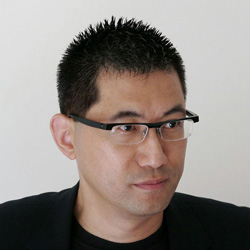

 Born in 1963 in Taipei, Taiwan. Jun-jieh Wang graduated from the Department of Visual Communication of the HdK
Art Academy in Berlin with a diploma in 1995 and completed a master class in 1996. He now lives and works in Taipei
as a multi-media artist. He also teaches at the art department at National Changhua University of Education and Taipei
National University of the Arts.
Born in 1963 in Taipei, Taiwan. Jun-jieh Wang graduated from the Department of Visual Communication of the HdK
Art Academy in Berlin with a diploma in 1995 and completed a master class in 1996. He now lives and works in Taipei
as a multi-media artist. He also teaches at the art department at National Changhua University of Education and Taipei
National University of the Arts.
In 1984, he received the Hsiung-Shih New Artists Award. Around that time, he began working with video and installation and became one of the pioneers of video art in Taiwan. In 1989, before leaving Taiwan, Wang collaborated with the New York media-watcher group Paper Tiger TV in producing the video "How History Was Wounded", which deals with the political stance of Taiwan's media during the June 4th Tiananmen incident.
In 1995, his video installation "Little Mutton Dumplings for the Thirteenth Day" won the Berlin Television Tower Award. The Tagesspiegel commented, "The Taiwanese multi-media artist Jun-jieh Wang wishes....to expose the madness of advertising through irony, exaggerations and improbabilities...The commercial clip aesthetics demonstrates Far Eastern precision."
In 1997, Wang represented Taiwan at the 47th Venice Biennial and participated in the 2nd Johannesburg Biennale as well as "Cities on the Move" at the Vienna Secession. He has participated in several important exhibitions since 1998, including at P.S.1 in New York, the Asian Art Triennale 1999 at the Fukuoka Asian Art Museum in Japan and the Asia Pacific Triennial in Queensland, Australia. He also took part in the 1998 and 2000 Taipei Biennial.
Jun-jieh Wang was selected by the prestigious Japanese art magazine "Bijutsu Techo" as one of the "100 notable artists in 2000". In 2002, Wang was the subject of Japan's NHK documentary "Asian Who's Who", which was aired on NHK's global channel.
In 2006, in collaboration with the National Symphony Orchestra, ROC, he served as Staging Visual Director for the Taiwan premiere of Wagner’s complete opera cycle Der Ring des Nibelungen.
In recent years, Wang has doubled as an independent curator. In 2004, he curated "Navigator: Digital Art in the Making", the first exhibition to introduce digital art to Taiwan on a large scale. The exhibition featured classic digital art works since the 90s and sparked local interest in the further exploration of technological art. Jun-jieh Wang's work as curator and exhibition designer includes: "Faces of the Time" (National Palace Museum, 2002), "Absolut Expressions" (Taipei Fine Arts Museum, 2002) , "Navigator: Digital Art in the Making" (National Taiwan Museum of Fine Arts, 2004), "The Post-Stone Age" (Art Taipei 2005), "Lots o'Lotto: Seen and Unseen" (Taipei Fine Arts Museum, 2005), "Vivienne Westwood" (Taipei Fine Arts Museum, 2005) and "B!AS: International Sound Art Exhibition" (Taipei Fine Arts Museum, 2005).